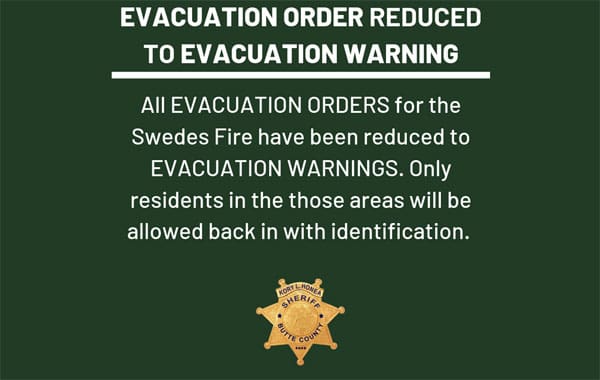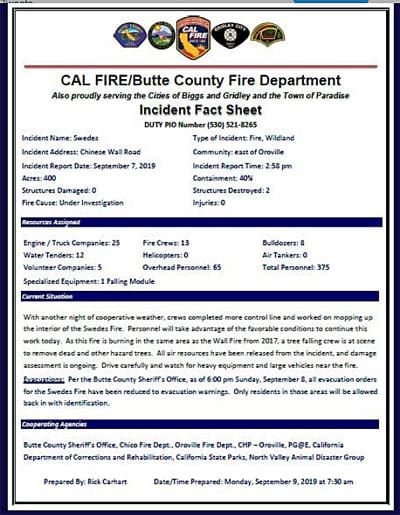We had a little practice fire drill here last week. I mean, there was an actual fire, and the mandatory evacuations that were ordered were close enough to have me putting my “go bag” by the back door and putting the dogs’ collars on and their go bags in the car. But we didn’t have to evacuate, and the fire crews got the fire subdued within 48 hours of its eruption, so that was all good.
However, I had the opportunity to help another friend who did have to evacuate, and we learned a few lessons together.
Lesson #1: Always Have Backup Phone Numbers
When I saw the location of the fire on the maps published by Cal Fire (the fire-fighting agency that responds to all fires in California that happen in the spaces between other fire-fighting jurisdictions) on Twitter, I texted my friend Dorothy right away; she was right in the path of the thing. No response. Then I called her. The call went straight to voicemail. Lesson number one: Have backup phone numbers! I have only her cell phone number, not her home phone number, and she only carries her cell when she’s not home. So, knowing that ahead of time as I did, I should really have made more of an effort to get her home number programmed into my phone.
I decided to head to her house. Already, there were California Highway Patrol cars parked in the area, blocking access to a number of roads near her – but fortunately her road was still accessible.

As I pulled my car into the front of her house, she was just getting out of her own car. It turns out that she had just gotten home from a long day out of town and was scrambling to catch up to the whole situation (and she never turns her phone on when she’s driving). She heard about the fire on the radio as she was driving home, and heard that there were mandatory evacuations on roads very close to her home. I gave her a hug and said, “Tell me what I can do.”
I should probably mention that my friend is 80 years old. She’s a very active 80-year-old; in fact, she is my horseback-riding buddy. She has three horses and still competes in endurance races. But she also has a 92-year-old husband who is not quite as active and able as she is, three cats, and one not-very-well-trained dog. We had some work to do.
The good news: Her horse trailer is always hooked up to her truck and ready to roll. It contains a dressing room that has a place for humans to sleep and a miniature kitchen and bathroom, so the cats and dog and humans can camp out in the there, too. The bad news: It’s a two-horse trailer and she has three horses.
She told me that she would send her husband to a friend’s house to stay. She could use some help to clean out a dog crate for the cats, and to get some feed for the horses and halter them. She would look for the cats and get her own things together. She said, “I can take the two horses to Camelot (a stable, the evacuation site for large animals in our area), drop them off, and come back.” OK, we had a plan.
Lesson #2: Always Have Important Addresses On Hand
I grabbed her dog, Maddie, who was already running around barking at everything, and put her in my car. I figured Dorothy would be able to catch the cats much more easily without Maddie underfoot. I filled up a bunch of buckets with hay cubes, and put halters on the horses. I tried to check Twitter, to see how the fire fighters were progressing, but I can’t get a signal at Dorothy’s house.
I said, “Let me take Maddie to my house. I have a big crate I can put her in. I will also get news about the fire and see if I can find another spot in someone else’s trailer for the third horse. Then I will call you on your cell, or text you anything important, so put your cell in your pocket.” She agreed.
I can’t get a signal until I am about two miles from Dorothy’s house. That’s why I got a little discombobulated when I reached another friend who has horses and who might have been able to pick up Dorothy’s third horse – and I realized I didn’t know Dorothy’s address, only how to get there. Lesson two: Make sure you have the physical address of the people you are trying to help!! I could neither ask Dorothy nor look at her street sign nor the number on her fence. I explained Dorothy’s location to my friend on the phone as well as I could, and said I would call her back and let her know the address for sure. I hoped we wouldn’t need the ride for that horse, that Dorothy had enough time to take two trips.
As I drove toward my home, I realized that I had recently loaned the crate that I intended to put Maddie in to another friend, who was out of town. Yikes! So I had to drive to that friend’s house, load the pieces of crate onto the top of my car and tie it down (it’s a Great Dane-sized crate made of flat panels that get fastened together in the corners with long rods), and then drive home. Once there, I checked the fire maps online. They hadn’t changed – but whether that was because the fire fighters were holding the line or because the news hadn’t updated yet, I did not know. I texted Dorothy a few times, with no response. I left Maddie in the big crate and headed back to Dorothy’s house.

Lesson #3: Always Have Backup Keys
By now, it was pitch dark outside. But as I pulled into her driveway, I could see that her husband’s car was gone; he had already left to stay with their friends. And two of the horses were in the trailer, and the cats were in the big dog crate, in the back seat of her crew-cab truck. Good, good, good! But Dorothy looked distraught and was near tears. “I lost the key to the truck!” she told me. “I had it with me, but now I can’t find it!”
Lesson number three: Always have a backup key to your getaway vehicles!
With smoke hanging thickly in the air, we searched for almost an hour. In her house. In the barn. Down the driveway. In the car. In the cab of the truck, the back of the truck, the dressing room of the trailer. I even opened the horse trailer door, where the horses waited impatiently and looked around their feet, in case she had dropped the key while tying their halter ropes. We were nearly in despair when I found the key in a place that Dorothy had already looked: under the hay that she had thrown to the horse that we were leaving behind. The horse had been eating this whole time, and the key and its ring was nearly buried in the dirt and picked-over hay, but I have never been so happy to see a glint of metal in a horse’s food in my life.
As I write this, days later, Dorothy and I have had a discussion about our little fire drill. I have put her address and home phone number into my phone. She is having a spare key made for her truck, and is going to hide it in a location in the barn that she will disclose to her sister (who lives nearby and also has horses) and me. We both are going to post a “to do” list of things that we don’t want to forget in the event of another evacuation or emergency. (She forgot a cell phone charger and her prescriptions, which fortunately weren’t absolutely needed to survive for the two days she stayed evacuated. When I went to her house in the dark, I forgot the flashlight that sits next to my back door, and nearly ran my cell phone down to zero battery by using its flashlight function instead. Dumb!)
Important Emergency-Preparedness Link
Here in rural Northern California, wildfire is always going to be a possibility, so all of us in this situation have to keep an evacuation plan in mind – for ourselves and for all of our animals. In other parts of the country, you may have to be ready for other natural disasters: hurricanes, tornadoes, earthquakes, floods, avalanches. Even those who live in cities should have a go-bag packed and ready with certain items, and a checklist of things to take along in case of a disaster. I can tell you that there is a huge difference between how much you will forget when you are thinking about it right now, while you read this in comfort and security on your computer or tablet, and how much you will forget if you are in the dark with the smell of smoke swirling all around and your beloved pets and family counting on you to get it together. So let this be my annual reminder to you! Make a checklist! Put together a go-bag! Update your phone and address book!
Here are some emergency-preparedness links I hope you find helpful:
https://www.ready.gov/build-a-kit
https://www.aspca.org/pet-care/general-pet-care/disaster-preparedness
https://www.fema.gov/media-library-data/1553273223562-797451b5cb0bee8d35d3e4e85e3830d6/Checklist.pdf






What a hair-raising tale! I’m so glad all of you got through it ok. Thank you for the helpful links.
glad it all worked out well for your friend, and thank you for this timely reminder and advice.
That was amazingly useful… thank you!
In addition, it’s always a wise idea to have a couple of emergency kits for both humans and animals ready at all times. One is a “stay” kit, the other is a “go” kit.
We live in hurricane country and can evacuate fairly easily.
Great article! I live in rural Idaho. It has and can happen here. Thanks for all the info and good reminders.
Good things to think about.
Maddie is beautiful and looks very trainable!
Thanks.
I agree with this.
But in addition to having spare keys. At least have the spare keys for all the doors and place them somewhere visible and easy to get when an emergency happens.
Important contact numbers must be updated saved on your mobile phone.
For the “go bag”, don’t forget to also include a whistle, flashlight, swiss army knife, first-aid kits canned foods and bottled water.